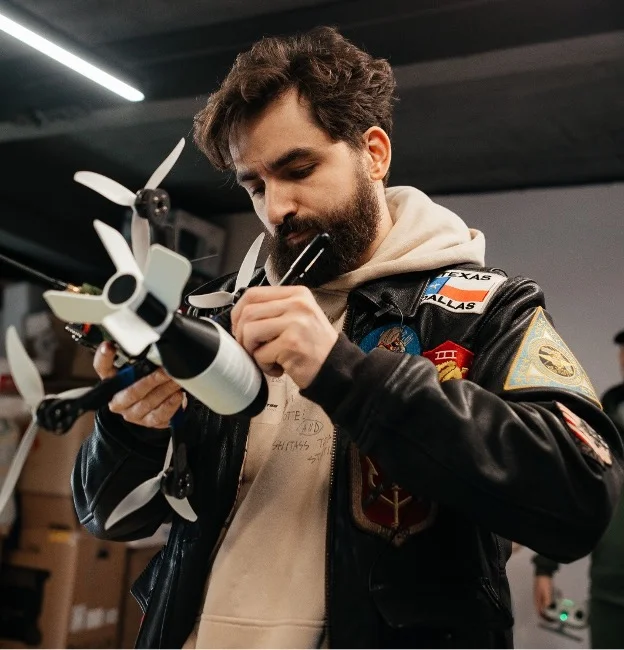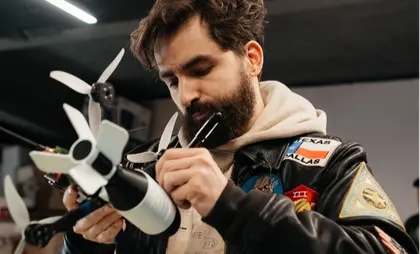Odesa entrepreneur and philanthropist Oleksandr Yakovenko is the owner of Supramarine, a logistics company . But he is well known for cultural projects and initiatives that have helped develop the city. After the full-scale invasion he started producing drones to support the Ukrainian soldiers.
How did this transformation happen?
On Feb. 24 [2022], the first day of Russia’s full-scale invasion of Ukraine, I immediately wrote to my employees: “Guys, you’ve got one day to decide whether to stay in Ukraine, or to leave. I will wait for your answer in my office, on the Feb. 25.”. And approximately 80 percent of my employees decided to stay in Ukraine and work together to fight against the invasion.
When I wrote to my employees, I still didn’t know what to do. First, we contacted some military units, to offer our help as a logistic company. They asked us, for example, to build anti-tank barricades in the city center and we made them from our equipment. This was our first step. The second one was to import to Ukraine medical help provided by our agents, a lot of international friends, and ourselves. Then we started to produce bulletproof vests, which our army lacked. We imported the steel from Sweden, a special armored material, and started to produce the plates. We created vests in our factory, in the garage, and we did it till the middle of July 2022. At that time, our government started to import them and had enough for the army.

‘Wild Hornets’ Latest Development Will ‘Sting’ Russian Shahed Drones
What made you decide to start up drone production ?
In July of last year, on my first time to the front line in southern Ukraine, I spent few weeks with our soldiers there and saw them using such drones in combat. One day we sought shelter in a basement, and the Russians found our location and tried to destroy it. It was a very stressful experience. I saw a member of our group going out from the protected shelter to pick up a drone, which had fallen 100 meters away. He needed to get it and went out there under fire. I asked him: “What are you doing?” He said: “It costs $300. We’ve only got three of them. We can’t lose it.”

Oleksandr Yakovenko tinkering with a drone
I understood two facts. First, the soldiers bought those drones by themselves, from their salary or pocket money. For me that was unbelievable. These people protect my country and myself, and they spend their own money to buy these drones. Second, they unfortunately did not have enough funds to buy the needed quantity. If you buy a few units it’s very expensive. That was when I made up my mind. I decided to buy a huge amount of this equipment and to provide all the necessary spare parts.
Was it difficult to start the production of a new item with no experience at all?
It’s not a new technology. These drones were used like toys before the war, nothing very difficult. You need to have good suppliers for spare parts and some engineers who assemble the drones.
The most difficult thing is to find the spare parts because you have to buy them from China. And there is a huge competition with the Russians, because they’ve started to do the same. For Chinese suppliers, it doesn’t matter if the clients are Russian or Ukrainian. We had no choice, because if we didn’t buy the spare parts, we would lose our quotas and the Chinese factory would give ours to the Russians. Nowadays, we produce approximately 500 pieces per week, at least 2,000 per month, which is a very good result.
We also created a school for drones operators. We teach about 100 students per month. Approximately, 20 percent of these students in future will be rather good drone pilots. We’ve even started to produce some additional equipment, like a special system to drop the grenades or other weapons. And in future we would like to produce small aircraft.
For us it’s not a commercial business, it’s like a charitable service
Do you mean unmanned aircraft? When does a drone become an aircraft?
It’s a kind of drone, but with wings. Our drones can only be used for eight to nine kilometers. Winged drones can fly for at least 30 kilometers. And we can also use them for intelligence tasks. We need to create something like the Russian Lancet. For our army it’s a huge problem, because they’ve destroyed a lot of our equipment with this type of drone. It’s like a Switchblade model, but cheaper, and they use it against us. We’ll try to do the same.
Was it hard to add this extra activity to your usual business?
It’s all about motivation. There’s no other motivation than to win this war and save our soldiers. Such tools help us, because with these drones our soldiers can avoid direct contact with the enemy. Unfortunately, Russia has also produced a lot of these drones recently. A year ago, we used them much more than our enemy.
One drone costs approximately $350 per unit. It’s a rather cheap price. On the market it’s much more expensive, approximately $500. But for us it’s not a commercial business, it’s like a charitable service. It means that we gather money thanks to donations and buy spare parts. As for the price, we try to provide it free of charge. We don’t earn any profit.
This is a completely new business for you. Did you recruit a special staff?
It’s a collaboration between civilian [enterprise] and the military. Our engineers are military, they started to produce these drones before us. We provide them equipment and spare parts, and any additional support they need. We also hired a chief engineer and we’ve got some other civilians who work in this factory, something like a 50 percent. Of course, they do not have enough money and enough funds. That’s why we need to we need to provide them at least the spare parts. It’s not about technology, it’s not engineering; 70 percent of this work is about the logistics and only 20 percent is concerned with the engineering to assemble these drones.
Did you receive some support from the Ukrainian government?
To be honest, we’ve got a huge problem with our government. Unfortunately, they do not support this production. Of course, they’ve done some good things. For example, they issued the law which provides tax exemptions for these components and I could import without any taxes. This is very good. But it would be better to receive an official order of drones from our government and be paid some money for it, because it’s very cheap and our army needs approximately 100,000 drones per month. It would cost about $30 million per month, compared to the cost of one single rocket for the Patriot system: $5 million. It is a very small, but strategic investment. And we need to invest more money. For example, a drone battery is very expensive to import from China to Europe by air, because it’s a dangerous cargo with a very high tariff. We import it by sea, in containers. A three-month trip.
The main problem is not the spare parts, it is the financial investment. For example, we pay in advance to the factory in China and the delivery to Ukraine is approximately two months later. It’s a huge amount of money for a volunteer organization, but not for the government. I do not understand why the government doesn’t invest in drone production. With one drone we usually destroy enemy equipment, which costs approximately half a million dollars.
Which business competence have you developed through this wartime activity?
We developed our expertise as a logistic company. Why are logistics is so important? Officially, DJI, the biggest producer of civilian drones from China, do not supply their drones to this war. They do not officially sell drones to either Russia or Ukraine, because they do not want to be sanctioned. But it’s very easy to get them, and everyone buys them. You buy the spare parts from Hong Kong and bring them to Lithuania, from Lithuania to Poland, from Poland to Ukraine. The Russian itinerary is approximately from China to Kazakhstan, to Turkey, to the Emirates, and finally to Russia. It’s a very difficult logistics, and there’s also the money logistics, because you can’t pay from Ukraine to China directly. You have to do it via different companies.
And then you have to work with transparency and official papers, because you received this money from donors, and you have to show them that everything is transparent. And when they ask you, for example, why you paid from Ukraine to Poland, you have to explain that you can’t pay from Ukraine to China directly – and then be ready to show the accounts of the Polish bank for China payments and all the invoices. We have to be transparent in one way, because we need people to trust us.
What have you learned about the future needs of Ukraine at war?
It is very important to start to produce spare parts for drones, like motors, in Ukraine, because in the near future China can stop shipping them to any Western country. To be independent with production is very difficult. There are four factories in China, which produce these drones. For example, there is another American company of drones, called EVO, also producing their drones in China. That’s why it’s difficult to be independent not only for Ukraine, but also for the US and EU countries. Still, we have to think about our future. We have no choice.
You can also highlight the text and press Ctrl + Enter






